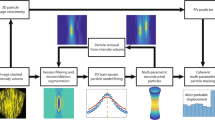Abstract
The turbulence structure of a horizontal channel flow with microbubbles is experimentally investigated using combined particle image velocimetry (PIV) in order to clarify the mechanism of drag reduction caused by microbubbles. A new system which simultaneously measures the liquid phase and the dispersed bubbles is proposed, based on a combination of particle tracking velocimetry (PTV), laser-induced fluorescence (LIF) and the shadow image technique (SIT). To accurately obtain the velocity of the liquid phase, tracer particles which overlap with the bubble shadow images are almost entirely eliminated in the post-processing. Finally, the turbulence characteristics of the flow field are presented, including measurements for both phases, and the bubble effect on the turbulence is quantified.














Similar content being viewed by others
References
Bröder D, Sommerfeld M (2002) An advanced LIF–PLV system for analysing the hydrodynamics in a laboratory bubble column at higher void fractions. Exp Fluids 33:826–837
Deutsch S, Moeny M, Fontaine A, Petrie H (2003) Microbubble drag reduction in rough walled turbulent boundary layers. In: Proceedings of the 4th ASME/JSME joint fluids engineering conference and FED summer meeting and exposition CD-ROM, Kauai, Hawaii, July 2003, paper no. FEDSM2003-45647, pp 1–9
Ferrante A, Elghobashi S (2004) On the physical mechanisms of drag reduction in a spatially developing turbulent boundary layer laden with microbubbles. J Fluid Mech 503:345–355
Hassan YA, Ortiz-Villafuerte J, Schmidl WD (2001) Three-dimensional measurements of single bubble dynamics in a small diameter pipe using stereoscopic particle image velocimetry. Int J Multiphase Flow 27:817–842
Hassan YA, Gutierrez TCC, Jimenez BJA, Dominguez OE (2004) Vortical structure modification by microbubble injection in a channel flow. In: Proceedings of the 5th international conference on multiphase flow (ICMF 2004) CD-ROM, Yokohama, Japan, May/June 2004, paper no. 367, pp 1–8
Ishikawa M, Murai Y, Wada A, Iguchi M, Okamoto K, Yamamoto F (2000) Novel algorithm for particle tracking velocimetry using the velocity gradient tensor. Exp Fluids 29(6):519–531
Kawakita C, Takano S (2000) Microbubble skin friction reduction under the influence of pressure gradients and curved surface (in Japanese). J Soc Naval Archit Jap 188:11–21
Kodama Y, Kakugawa A, Takahashi T, Kawashima H (2000) Experimental study on microbubbles and their applicability to ships for skin friction reduction. Int J Heat and Fluid Flow 21:582–588
Kodama Y, Kakugawa A, Takahashi T, Nagaya S, Sugiyama K SR239 Committee (2002) Microbubbles: drag reduction mechanism and applicability to ships. In: Proceedings of the 24th symposium on naval hydrodynamics, Fukuoka, Japan, July 2002, pp 1–20
Lindken R, Merzkirch W (2002) A novel PIV technique for measurements in multiphase flows and its application to two-phase bubbly flows. Exp Fluids 33:814–825
Madavan NK, Deutsch S, Merkle CL (1984) Reduction of turbulent skin friction by microbubbles. Phys Fluids 27:356–363
McCormick ME, Bhattacharyya R (1973) Drag reduction of a submersible hull by electrolysis. Nav Eng J 85:11–16
Minato D, Tanaka T, Fujiwara A, Hishida K, Maeda M (2003) Particle tracking velocimetry measurement of bubble–bubble interaction. In: Proceedings of the 4th ASME/JSME joint fluids engineering conference and FED summer meeting and exposition CD-ROM, Kauai, Hawaii, July 2003, paper no. TED-AJ03–198
Moriguchi Y, Kato H (2002) Influence of microbubble diameter and distribution on frictional resistance reduction. J Mar Sci Technol 7: 79–85
Moser RD, Kim J, Mansour NN (1999) Direct numerical simulation of turbulent channel flow up to Re τ =590. Phys Fluids 11(4):943–945
Nagamatsu T, Kodama Y, Kakugawa A, Takai M, Murakami K, Ishikawa S, Kamiirisa H, Ogiwara S, Yoshida Y, Suzuki T, Toda Y, Kato H, Ikemoto A, Yamatani S, Imo S, Yamashita K (2002) A full-scale experiment on microbubbles for skin friction reduction using SEIUN MARU part 2: the full-scale experiment (in Japanese). J Soc Naval Archit Jap 192:15–28
Nishino K, Kasagi N, Hirata M (1989) Three dimensional particle tracking velocimetry based on automatic digital image processing. ASME J Fluid Eng 111:384–391
Otsu N (1979) A threshold selection method from gray-level histograms. IEEE Trans Syst Man Cybern SMC 9(1):62–66
Schlichting H (1979) Boundary layer theory 7th ed. McGraw-Hill, New York
So S, Morikita H, Takagi S, Matsumoto Y (2002) Laser Doppler velocimetry measurement of turbulent bubbly channel flow. Exp Fluids 33:135–142
Takehara K, Etoh T (1999) A study on particle identification in PTV. J Visualization 1(3):313–323
Tokuhiro A, Maekawa M, Iizuka K, Hishida K, Maeda M (1998) Turbulent flow past a bubble and an ellipsoid using shadow–image and PIV techniques. Int J Multiphase Flow 24:1383–1406
van der Brug GJ (1977) Experiments in iterative enhancement of linear features. Comput Graph Image Processing 6:25–42
Xu J, Maxey MR, Karniadakis GE (2002) Numerical simulation of turbulent drag reduction using micro-bubbles. J Fluid Mech 468:271–281
Yamamoto F, Wada A, Iguchi M, Ishikawa M (1996) Discussion of the cross-correlation methods for PIV. J Flow Visual Image Processing 3(1):65–78
Acknowledgements
This work was carried out as a research activity at the Center for Smart Control of Turbulence funded by the Ministry of Education, Culture, Sports, Science and Technology, Japan. We would also like to thank Dr. Sugiyama at the National Maritime Research Institute and Dr. Fujiwara at the University of Tokyo for their comments on this paper.
Author information
Authors and Affiliations
Corresponding author
Rights and permissions
About this article
Cite this article
Kitagawa, A., Hishida, K. & Kodama, Y. Flow structure of microbubble-laden turbulent channel flow measured by PIV combined with the shadow image technique. Exp Fluids 38, 466–475 (2005). https://doi.org/10.1007/s00348-004-0926-8
Received:
Revised:
Accepted:
Published:
Issue Date:
DOI: https://doi.org/10.1007/s00348-004-0926-8




